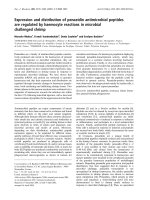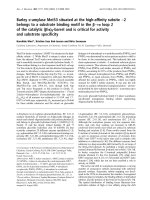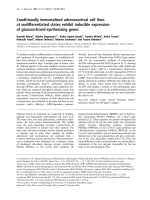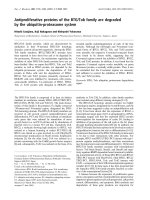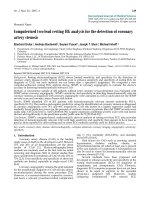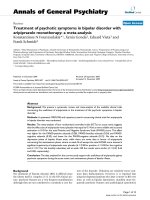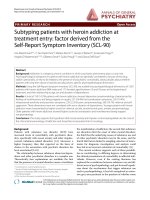Báo cáo y học: " World AIDS Day 2007: AIDS at 26, are we there yet? Kuan-Teh Jeang" pps
Bạn đang xem bản rút gọn của tài liệu. Xem và tải ngay bản đầy đủ của tài liệu tại đây (178.16 KB, 2 trang )
BioMed Central
Page 1 of 2
(page number not for citation purposes)
Retrovirology
Open Access
Editorial
World AIDS Day 2007: AIDS at 26, are we there yet?
Kuan-Teh Jeang
Address: The National Institutes of Health, Bethesda, MD, USA
Email: Kuan-Teh Jeang -
Abstract
This editorial comments on selected progress made in combating the acquired immune deficiency
syndrome (AIDS) after 26 years and some of the remaining challenges.
It has been 26 years since the acquired immune deficiency
syndrome (AIDS) was first recognized (see review [1]). In
the ensuing time, AIDS has become an unprecedented
global pandemic. Today, approximately 33 million peo-
ple worldwide are infected with HIV, the virus that causes
AIDS. In 2007, 2.5 million people became newly infected;
and around 2.1 million died of AIDS in 2006. Each day,
~10,000 new individuals become HIV seropositive with
95% residing in resource-poor developing nations. A
cumulative global count shows that more than 25 million
people have already died from AIDS, a number exceeding
60 times the total American casualties in World War II.
Regrettably, half of all people are infected with HIV before
age 25, and are killed by AIDS before they turn 35.
Progress and Challenges
More than a quarter century of AIDS later, where do we
stand against this disease? A couple of advances amongst
many warrant measured optimism. First, we have made
remarkable strides in developing antiviral drugs or antiret-
rovirals (ARVs). Since 1996, ARVs have saved an esti-
mated 3 million life-years in the United States alone. An
upside to this therapeutic advance is that currently more
than 2 million HIV-positive people are being treated with
ARVs. While drug resistant viruses continue to be a signif-
icant issue [2], this past year saw the emergence of a new
class of drugs targeted against the HIV-1 integrase enzyme
[3]. Different from inhibitors that target the reverse tran-
scriptase and protease enzymes and drugs that affect viral
entry into the cell, this new integrase inhibitor will pre-
vent the viral DNA from inserting itself into the host cell
genome. A downside to treatment remains that still less
than 20% of the world's population has access to HIV
drugs and prevention programs, and that for every one
person who gains therapy, six others become newly HIV-
infected without the prospect of future treatment. Ongo-
ing investments from the United States President's Emer-
gency Plan for AIDS Relief [4], the Global Fund to Fight
AIDS, Tuberculosis and Malaria, and many other pro-
grams are making steady progress in attempting to turn
the tide on worldwide treatment access. Second, a wel-
come development is the recent documentation that cir-
cumcision reduces by approximately 50% a man's risk of
acquiring AIDS sexually. This piece of good news suggests
that there is still much to be gained through public health
prevention measures. Independent of drug therapy, edu-
cation, condoms, circumcision, abstinence, and other
intervention strategies may yield significant and yet
unharvested global benefits.
There have also been two notable recent disappointments.
The first is the serious setback of the failed clinical vaccine
trial from the collaborative efforts of Merck & Co., Inc.,
the US National Institute of Allergy and Infectious Dis-
eases (NIAID), and the HIV Vaccine Trials Network
(HVTN). In this sizable clinical trial, 49 of 914 vaccinated
men tested positive for HIV, compared to 33 of 922 men
who received a placebo vaccine [5]. These results illustrate
Published: 1 December 2007
Retrovirology 2007, 4:86 doi:10.1186/1742-4690-4-86
Received: 21 November 2007
Accepted: 1 December 2007
This article is available from: />© 2007 Jeang; licensee BioMed Central Ltd.
This is an Open Access article distributed under the terms of the Creative Commons Attribution License ( />),
which permits unrestricted use, distribution, and reproduction in any medium, provided the original work is properly cited.
Publish with BioMed Central and every
scientist can read your work free of charge
"BioMed Central will be the most significant development for
disseminating the results of biomedical research in our lifetime."
Sir Paul Nurse, Cancer Research UK
Your research papers will be:
available free of charge to the entire biomedical community
peer reviewed and published immediately upon acceptance
cited in PubMed and archived on PubMed Central
yours — you keep the copyright
Submit your manuscript here:
/>BioMedcentral
Retrovirology 2007, 4:86 />Page 2 of 2
(page number not for citation purposes)
a disappointing lack of vaccine efficacy and dash the hope
that a useful HIV-vaccine will be available any time soon.
As the Merck vaccine was based on the induction of cellu-
lar immunity by HIV proteins expressed from an adenovi-
ral vector, we will likely see a return to attempts to modify
the viral envelope protein in such a way to induce neutral-
izing antibodies. This seems a formidable task that
requires innovative approaches, as all the standard ways
to make such an envelope immunogen have failed. A sec-
ond less visible but perhaps equally troubling concern is
our continued inability to develop a safe and effective
anti-HIV microbicide for women [6]. In sub-Saharan
Africa, women between the ages of 15–24 are three times
more likely than men to become infected with HIV. Our
failure to empower women to protect them against HIV/
AIDS poses a sobering challenge.
Leadership
The theme of this 20
th
World AIDS Day is "leadership".
This is a day to consider how we can exercise leadership
on new innovations and vision. With increased globaliza-
tion, today's world is much different from what it was 26
years ago; and very likely, the world will be further differ-
ent in 26 more years. Several respected sources have pro-
jected that by 2040 China will have overtaken the United
States to become the world's largest economy with India
capturing third place. Official AIDS statistics in 2005 place
China's HIV-cases at 650,000. With her population of 1.3
billion people, China's future HIV numbers will surely
rise [7]. Nevertheless, the good news is that China's econ-
omy is robust and has amassed an estimated foreign
reserve of over 1.4 trillion US dollars. In the near future,
one could expect China to begin contributing to eco-
nomic leadership in the global fight against AIDS. Perhaps
2008, the year of the 29th Olympic games to be held in
Beijing, would present an excellent time for China's initi-
ative in the service of global human health.
Today is also a day for the AIDS/HIV medical and research
communities to reflect on new ideas, new targets [8] and
to call on fresh voices. One senior researcher commented
recently that he has been going to major HIV meetings for
the last fifteen years and have heard over that period
largely the same voices speak about AIDS vaccines. On
World AIDS Day 2007, let's mark the progress already
accomplished, persevere in good research while seeking
new approaches from unheard voices. AIDS at 26, are we
there yet? Not quite.
Acknowledgements
I thank Ben Berkhout, Mark Wainberg, and Andrew Lever for critical read-
ings of this writing. The opinions here represent the author's personal
views, and do not reflect those of the author's employer or Biomed Cen-
tral.
References
1. Gallo RC: A reflection on HIV/AIDS research after 25 years.
Retrovirology 2006, 3:72.
2. Baldwin CE, Berkhout B: HIV-1 drug-resistance and drug-
dependence. Retrovirology 2007, 4:78.
3. Traynor K: Integrase inhibitor gains FDA approval. Am J Health
Syst Pharm 2007, 64:2310.
4. Lo B, Padian N, Barnes M: The obligation to provide antiretro-
viral treatment in HIV prevention trials. AIDS 2007,
21:1229-1231.
5. HIV vaccine failure prompts Merck to halt trial. Nature 2007,
449:390.
6. Klasse PJ, Shattock R, Moore JP: Antiretroviral Drug-Based
Microbicides to Prevent HIV-1 Sexual Transmission. Annu
Rev Med 2007.
7. Shao Y: AIDS epidemic at age 25 and control efforts in China.
Retrovirology 2006, 3:87.
8. Nielsen MH, Pedersen FS, Kjems J: Molecular strategies to inhibit
HIV-1 replication. Retrovirology 2005, 2:10.

